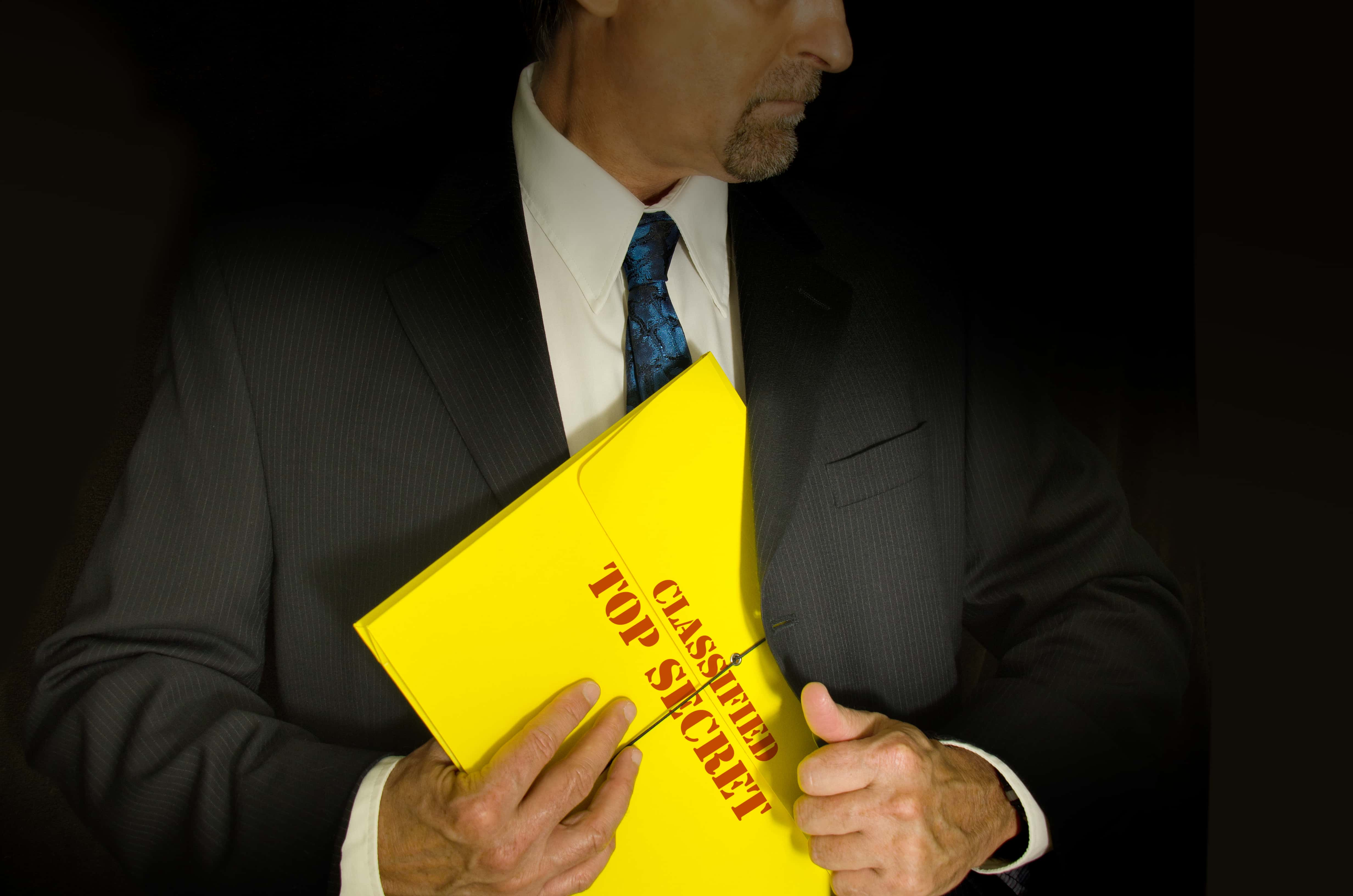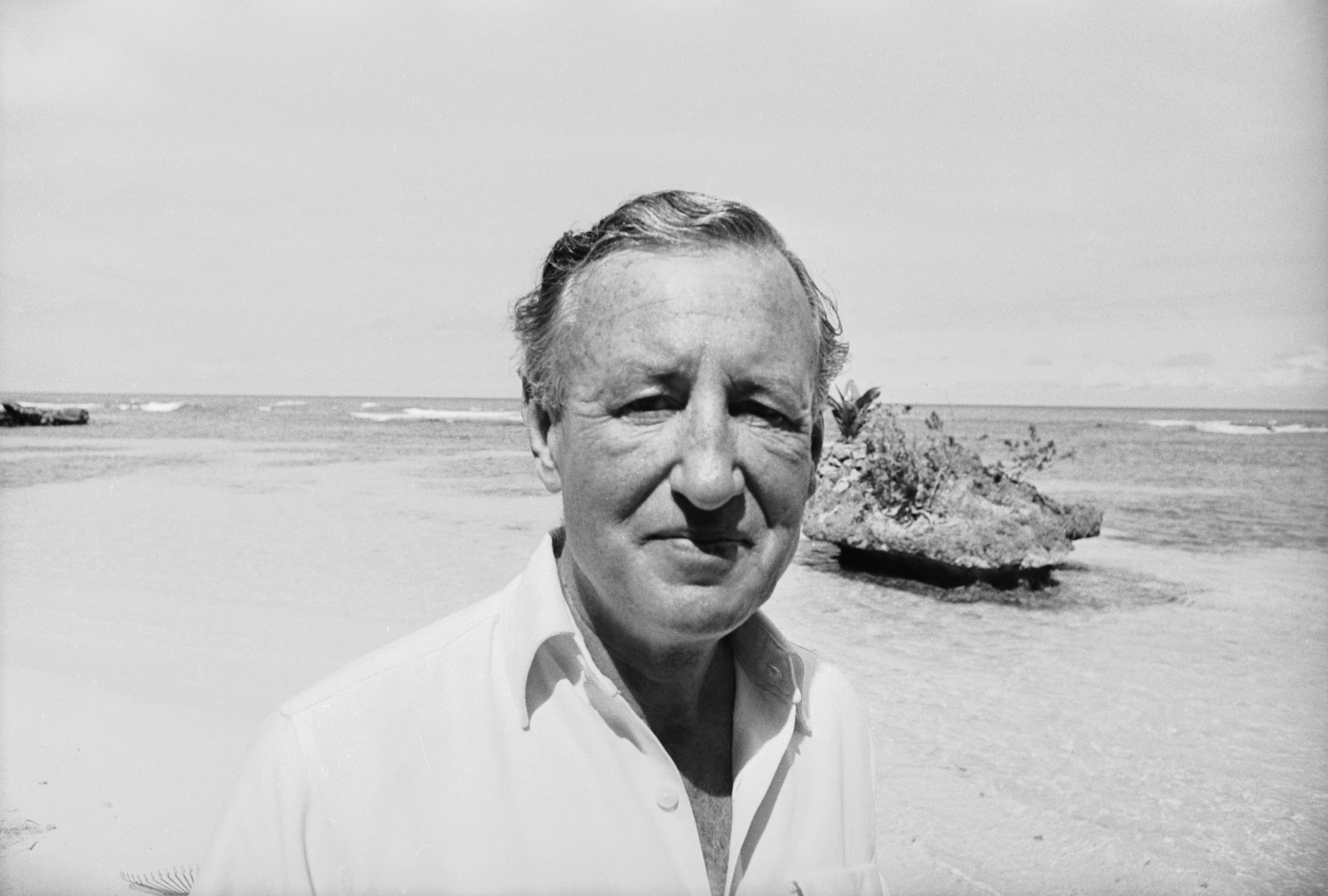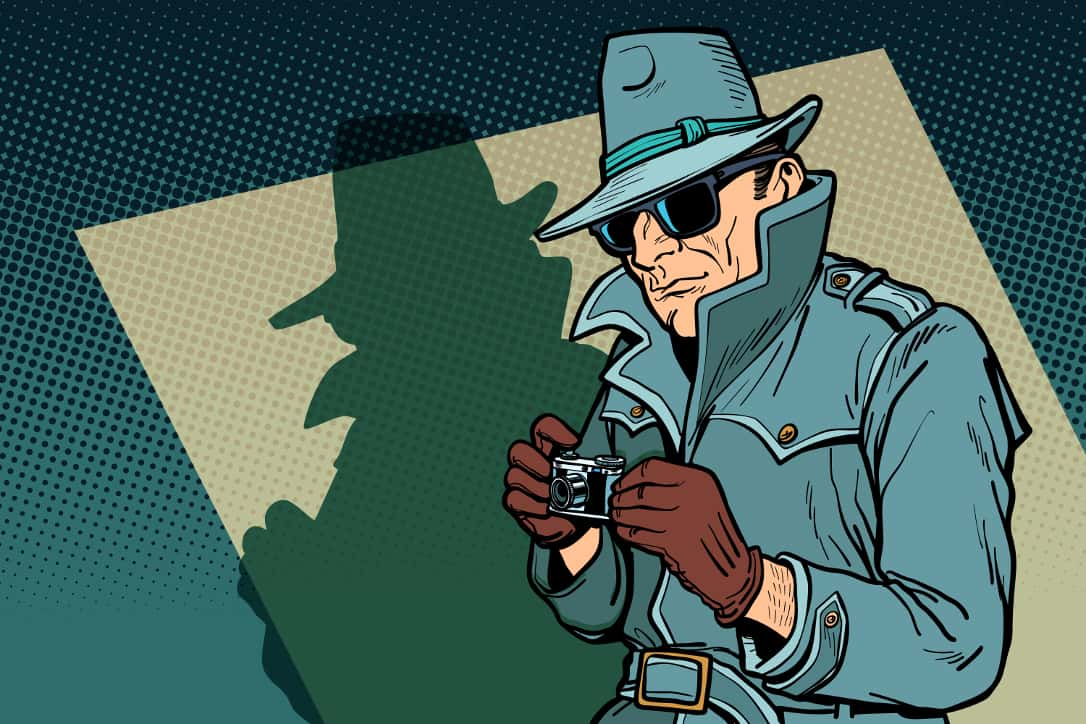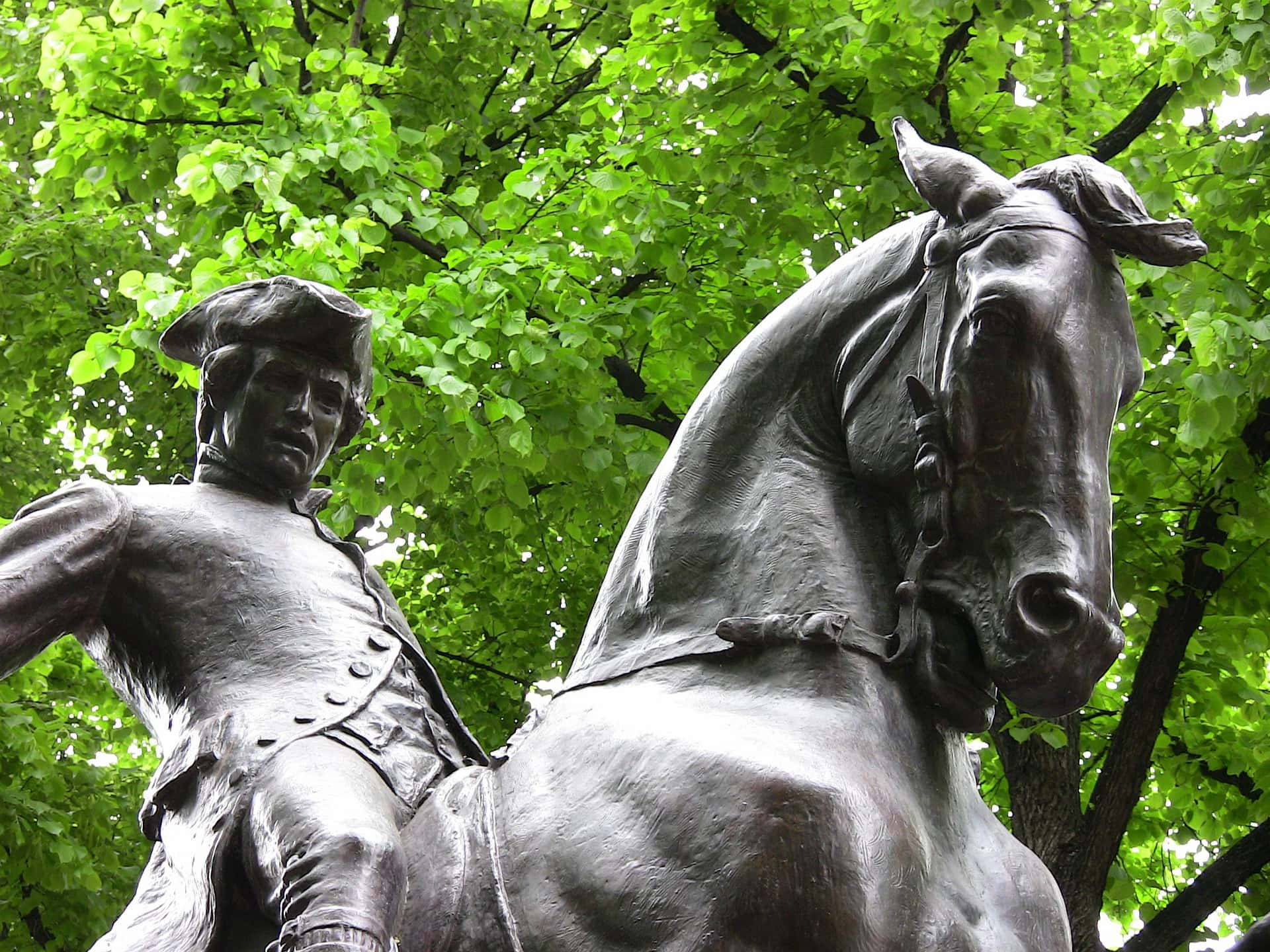When most of us picture the life of a spy, we imagine something out of James Bond. Jetpack gunfights and martinis on the moon, right? Well... sort of. Although the world of espionage can certainly be glamorous at times, what the movies always seem to miss is just how utterly bizarre it can be as well. Don't believe us? Well check out these 47 devious facts about the world of spies and espionage.
Just remember, we warned you.
Espionage Facts
47. Loving A Spy
Being tapped can come in handy.
One CIA officer in the Soviet Union used an unsecured phone line to make a dinner date. One the way, he realized that the KGB were driving both in front of and behind him—so when he got lost, he simply followed the KGB straight to the restaurant.
46. The Dangers Of Espionage
Cold War suicide glasses had a single cyanide pill hidden in the arm. When a spy found themselves in trouble, they could chew on the arm of the glasses to poison themselves and avoid torture. Playing with your glasses is a pretty common nervous habit, one that hopefully none of the aforementioned spies were afflicted with.
45. A Telltale Staple
Russia used an incredibly subtle trick to identify hundreds of spies: Americans would use good-quality, rust-proof staples on their documents, whereas actual Russians used cheap staples that left a rust stain behind.
44. Oral Exam
Soviet spies often had the...uh... sensitive task of seducing high-ranking men and blackmailing them for information.
One former sex spy described the training she received, which included filming orgies with classmates and critically evaluating the tapes afterward.
43. Optical Zoom
The cameras in spy satellites have such powerful zoom, they can photograph license plates clearly from 50 miles up in space.
Remember that the next time you think nobody's watching...
42. Death To Spies And Espionage
SMERSH, the Soviet intelligence agency that employed Dr. No and Goldfinger in the James Bond novels, actually existed. Smert Shpionam, AKA “Death to Spies”, was an organization in operation during the Second World War, and one of their missions was the recovery of fragments of Hitler’s skull. We know Bond is already in the mix, but it also sounds like a great plot for an Indiana Jones movie.
41. Doctor of Espionage
The CIA actually runs both a university and a grad school program which train students in technology, language, and other subjects that are especially useful to spies.
40. Dim-Witted Double Agent
Earl Pitts spied for the Russians while working for the FBI in the ‘80s and ‘90s. The FBI set up a sting operation to catch him, but Pitts inadvertently thwarted their attempt—by forgetting where to meet his contact. He wandered around the wrong part of the New York Public Library for half an hour before giving up and leaving.
39. Odd Proposal
Anna Chapman—AKA Anya Kushchenko—began spying for Russia in the 2000s and became famous for it back in Russia. When the Russian government tasked her with keeping Edward Snowden in the country, she attempted to seduce him by proposing over Twitter.

History's most fascinating stories and darkest secrets, delivered to your inbox daily.
38. CIA “Bug”
As early as the 70s, the CIA was experimenting with a drone spy gadget—disguised as a dragonfly.
This tiny UAV (unmanned aerial vehicle) was powered by a gas engine. But it also had a major flaw: all it took was a crosswind to knock it off course.
37. Using Your Head
All kinds of everyday objects have been used to conceal spy gear. One inventive example is a pipe with a tiny radio concealed inside it. No speakers required—sound waves traveled through the jaw bone straight to the ear canal.
36. Wanted Dead or Alive
Christine Granville—AKA Krystyna Skarbek—a former Miss Poland, spent the late stages of WWII spying for the British in France. When she ran afoul of the Gestapo, not only did she convince them of her cover story, but she also got them to release two more captured spies—even though their office walls were plastered with her picture on Wanted posters!
35. Close Call
Called “the Strangest Man to Ever Play Baseball", Boston Red Sox catcher Morris “Moe” Berg possessed a dazzling intellect. Berg would sometimes read ten newspapers simultaneously. Berg’s gifts for language and memorization caught the attention of OSS officials, and Berg spent the war interviewing European physicists, tracking Germany’s progress on the atomic bomb.
At one point, he went into enemy territory to attend a lecture by Nobel Prize-winning German physicist Werner Heisenberg. If he determined that Heisenberg seemed close to building an atomic bomb, he was to assassinate the scientist on the spot. Luckily for Heisenberg, he wasn’t close at the time.
34. Punch-Out
One deadly spy gadget was the glove pistol. Mounted on the back of a glove, the trigger was activated by punching the target, which would shoot them at point-blank range. This gun came in “handy” when the spy was caught: they could innocently put their hands up, then punch the enemy in the head once they came closer.
 Wikimedia Commons, Joyofmuseums
Wikimedia Commons, Joyofmuseums
33. Lonely Hearts
There was such a problem with lonely secretaries being seduced by “Romeo” Soviet spies in East Germany, that NATO had to hang posters in their offices reminding ladies to keep their hearts closed.
32. Stick It Where the Sun Don't Shine
Desperate times call for desperate measures. The CIA designed a tiny anal toolkit, which a spy could hide in their posterior in case of trouble. Once captured, the spy would simply poop out the toolkit and make their escape.
31. Check Your Prejudice
John Scobell was an educated former slave living in the North when the American Civil War broke out. Scobell went to the South as a spy, and used the Confederates’ racism against them: officers did nothing to protect their information when he was around because they assumed he couldn’t understand it.
30. Earning Accolades
Eddie Chapman was an Englishman who spied for the Germans in WWII. When he parachuted into England with a mission to blow up a factory, he instead contacted MI5 and offered to become a double agent. The English faked the factory explosion, and Germany was so convinced that they awarded Chapman a medal.
 Getty Images
Getty Images
29. Wild Bill
Before the CIA, there was the Office of Strategic Services. The OSS was headed by William “Wild Bill” Donovan. Donovan had caught the attention of governmental higher-ups first as a soldier in WWI, and then as a zealous smasher of speakeasies during the Prohibition Era. Prior to being posted as head of the OSS, President Roosevelt had offered Donovan the governorship of the Philippines (which Donovan declined.)
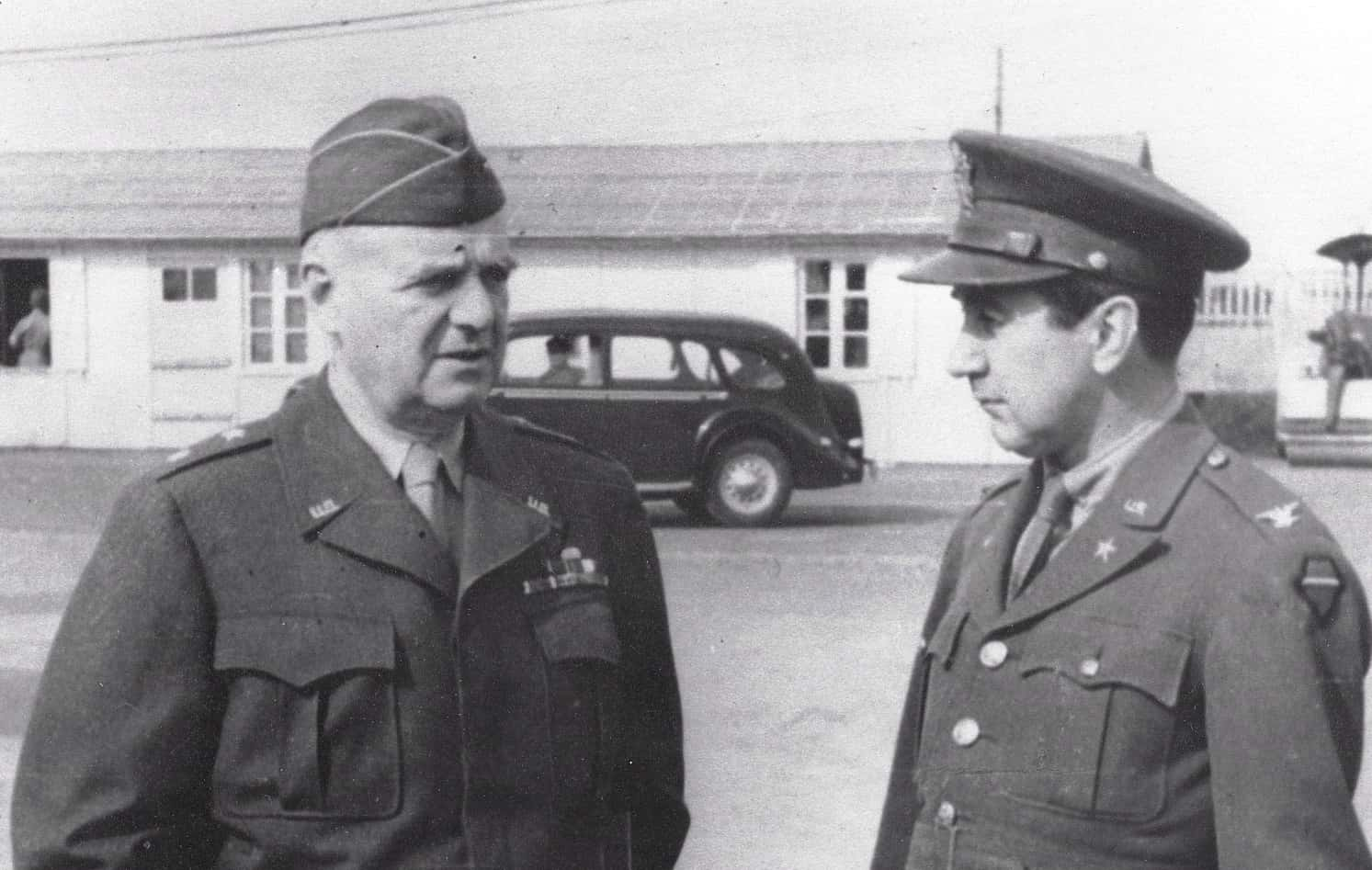 Wikimedia Commons, US Army Signal Corps
Wikimedia Commons, US Army Signal Corps
28. Blame Canada
A Canadian named Alexander Keith Jr.—nephew of Halifax beer baron Alexander Keith—worked with a Confederate spy ring in Canada during the American Civil War. One of the plans he hatched was to spread Yellow Fever among the Yankees by smuggling dead people’s clothes over the border. As long as you don’t put it in the beer, dude!
27. Beat That, Shakespeare
Christopher Marlowe, the English playwright and contemporary of William Shakespeare, might have been a spy for the British government. He did have a history of getting into legal scrapes that the government would smooth over. The Privy Council also ordered Cambridge University to grant Marlowe an MA, saying that they needed him for “matters touching the benefit of his country.”
26. Novelist and Spy
Daniel Defoe was an English writer famous for the novel Robinson Crusoe. Defoe was also a spy for the English government. He earned the trust of the Scottish elite and covertly helped push Scotland into accepting union with England, even becoming an advisor to Scottish parliamentary committees.
25. Spy with a Conscience
Israeli Sarah Aaronsohn joined an espionage ring in 1915 after she witnessed Turkish soldiers brutally executing 5,000 Armenians. The Turks captured Aaronsohn two years later and tortured her for information on her fellow spies. Aaronsohn refused to talk and held out long enough to shoot herself with a smuggled pistol.
24. Cheaters Never Prosper
One Elizabethan spy made a grave mistake in trying to play both the Queen and the Pope. William Parry had spent his career spying on Catholics for Queen Elizabeth. In 1583, he ran out of money and tried to write the Pope, offering his espionage services to him and the Catholic Church. Unfortunately, he was found out just two years later. Elizabeth had pardoned him from death before, related to previous assault charges, so she showed no mercy this time: Parry was hanged, drawn, and quartered for his involvement in a royal assassination attempt.
23. Implausible Deniability
The British government didn’t acknowledge the existence of MI6—James Bond’s employers—until 1994.
22. Hauling Them Over the Coals
Some of the best spy weapons don’t look like much. During the American Civil War, the Confederates disguised bombs to look like lumps of coal. When a Union sailor shoveled the coal bomb into their ship’s boiler, the explosion was big enough to cause serious damage—as many as 60 Union ships were destroyed this way.
21. Fact and Fiction
James Bond author Ian Fleming was friends with CIA Director Allen Dulles. When Fleming complained to Dulles that the CIA’s spy gadgets were too boring, Dulles knew just where to find inspiration.
Shortly afterward, the CIA created shoe daggers and homing devices... innovations that were straight out of the James Bond novels.
20. An Artist at Work
Spies can find the strangest ways to ingratiate themselves with their targets. Petrus Alamire had a workshop that produced exceptionally beautiful sheet music manuscripts. European royalty would ask to meet this incredible artist, and Alamire would steal the secrets of their court.
19. That’s A Stretch
Long before she was the world’s most famous chef, Julia Child was a researcher for the OSS. She began working for the spy agency as a typist (she had been too tall to join the Women’s Army Corps), which led to her handling classified documents in Sri Lanka.
18. Great Souvenir
Even when a mission goes off without a hitch, spies don’t always get what they expected. When the KGB showed Indonesian President Sukarno video of him having an orgy with several beautiful Soviet spies, they thought they were blackmailing him. Instead, he liked the tape so much that he asked for copies.
17. Quit Stalin
Joseph Stalin really didn’t like Josip Broz Tito, Yugoslavia’s head of state. Tito got so fed up with the constant stream of spies attempting to assassinate him, that he sent this message to Stalin: “If you don’t stop sending killers, I’ll send one to Moscow and I won’t have to send a second.” Despite attempts including a specially-designed disease and a poison jewelry box, Tito outlived Stalin by 30 years.
16. Hotel Estonia
The KGB had extremely advanced audio surveillance technology during the Cold War, and they took advantage of it. One hotel in Estonia, popular with international travelers, had 60 rooms permanently wiretapped, while the KGB occupied an entire floor for constant monitoring and espionage.
15. A Full Life
Pierre Beaumarchais, author of The Barber of Seville and The Marriage of Figaro, held down several jobs in his life, including writer, watchmaker, music tutor to French princesses, and spy. Among his espionage activities, he helped bring France into America’s Revolutionary War. He once said, “If time were measured by the events that fill it, I have lived two hundred years.”
14. The Unassuming Barber
Karl Schulmeister was a spy for Napoleon Bonaparte, and a quick thinker. One time, when a group of Austrian soldiers found Schulmeister, they chased him into a boarding house. They found a barber, complete with towels and razors, who told them the spy had gone upstairs—and as the Austrians raced upstairs, Schulmeister ditched his barber props and made his escape.
13. Clever AF
During WWII, the Americans intercepted Japanese messages saying they would attack a target called “AF”. Unsure what they meant, the Americans took a guess and sent out messages falsely stating that the Midway Atoll had a water shortage. When Japanese communications started reporting a water shortage in “AF”, the Americans knew where to set up defenses.
12. Espionage Expert
Col. George Trofimoff of the US Army worked in military intelligence, with top-level security clearance. He was also a spy for the Soviets, and passed along 50,000 pages of data over the course of 25 years. He is the highest-ranking American officer to ever be convicted of spying.
11. Family Business
If you’re going to recruit family into the espionage business, be sure to stay on their good side. John Walker worked for the US Navy and was a Soviet spy for 17 years. In that time, he convinced his wife Barbara, his brother Arthur, and his son Michael to help out—but when he divorced Barbara and refused to pay his alimony, she went straight to the FBI.
10. Sex, Drugs, and Military Invasions
In the 1940s, the Nazi SS decided to bug a Berlin brothel, Salon Kitty, in order to record high-ranking Nazis in compromising situations for potential blackmail. The plan went awry when a British spy tapped into Salon Kitty’s surveillance system and recorded Joachim von Ribbentrop plotting an imminent invasion of Gibraltar.
9. Jack in the Box
When you know you’re being tracked, you have to get creative. One CIA officer who had a rendezvous in Moscow arranged a fake birthday party. He and his driver brought a fake birthday cake in the car with them, knowing the KGB were tailing them. The car took a sharp turn to elude their trackers, the CIA officer jumped out, and a silhouette popped out of the cake so it would look like he was still in the car.
8. Uncanny Resemblance
Gabriele Kliem had once dated a handsome scientist, and never quite got over him. So when she met Frank Dietzel, who looked just like her ex and worked for a world peace organization, Kliem was happy to hand over intel from her job at the US Embassy in East Germany. In the seven years they were engaged, Kliem never knew Dietzel was actually a KGB agent with a family back home, chosen specifically for the job because he resembled her ex.
7. Quite the Trip
The CIA set out to building safehouses in New York and San Francisco for the sole purpose of studying the effects of LSD on non-consenting subjects. One outfit was called Operation Midnight Climax: In order to lure people into these safe houses, the CIA had several prostitutes on their payroll—yes, you read that correctly—who would entice “clients” to come back to the houses. Once there, the prostitutes would dose them with various substances—most famously LSD. The subjects were then monitored behind a two-way mirror. It is alleged that the officials who ran the experiments described them as "fun, fun, fun. Where else could a red-blooded American boy lie, kill, cheat, steal, rape and pillage with the sanction and bidding of the All-highest?
6. Spying Over Some Drinks
In the mid-1770s, long before his famous ride, Paul Revere formed an amateur spy ring.
The group came about in response to the brewing conflicts between the Patriots and loyalists of the Thirteen Colonies. Named the “Mechanics,” Revere and his associates would report on “the Movements of British Soldiers” and pass on any information they could acquire to their allies.
Rather than a secret tower or underground base, the Mechanics’ headquarters was the Green Dragon, Revere’s favorite pub and watering hole. Not exactly subtle, but what the hey!
5. Explosive Contributions
That wasn't the end of Paul Revere's espionage exploits...
During the Revolutionary War, a serious concern among the patriot forces was a lack of gunpowder. Since there was only one powder mill in all of the Thirteen Colonies, and he’d already proven himself to be a highly adaptable jack-of-all-trades, Revere was sent to study the details of the mill in Philadelphia so that a second one could be built exclusively for the patriot cause.
Revere’s mission was successful—despite the owner demanding a hefty bribe for his information—and a powder mill was built at Stoughton, which is now known as Canton, in Massachusetts.
4. Paperclips Got Us To The Moon
One of the leading figures of America's quest to land men on the moon actually started his career as a rocket scientist working for the Germans.
Wernher von Braun is considered the father of rocket technology. During the war, he helped to design the V-2 rocket— a weapon the Germans hoped would be their saving grace in a war that, by the mid-40's, was beginning to look unwinnable.
After the war was won, Von Braun was secretly repatriated to the United States (along with thousands of other leading German scientists) as part of a government program called Operation Paperclip. He was soon assigned to the rocket task-force at NASA, and served as the chief engineer for the Saturn V rocket. No big deal, though— the Saturn Five was only the engine that propelled Apollo 11 to the moon.
3. This Is the End
Mata Hari, the Dutch exotic dancer who spied for the French, was executed in 1917 for being a German double agent.
According to witnesses, Hari refused to be blindfolded as she faced the firing squad who were about to take her life. She did not flinch as the soldiers opened fire, and even after she’d been struck, her face did not change expression.
Unfortunately, for those who want a juicier story, Wales doesn’t mention anything about her supposedly stripping down to her birthday suit to persuade the soldiers not to shoot her (as some sources have stated she did). She did, however, blow a kiss to her executioners in her final moments.
2. Off With Her Head
A double agent prevented an assassination attempt against Queen Elizabeth I. Gilbert Gifford hid messages in beer barrels destined for Chartley Hall, where Mary, Queen of Scots, was imprisoned. He helped to sneak messages between Mary and her supporters, but at the same time he secretly deciphered the notes and passed information to Elizabeth. This intel finally convinced Elizabeth to have Mary beheaded.
1. Slapstick Espionage
When Rome was embroiled in a devastating war against Carthage in 204 BC, they needed every advantage they could get. So, they sent an envoy to the Carthaginian camp with some inept servants on hand. The “servants” were actually centurions—they let a horse get loose, and as they chased it around the camp, they noted the precise weaknesses that would allow them to burn it down a few days later.
Sources: 1, 2, 3, 4, 5, 6, 7, 8, 9, 10, 11, 12, 13, 14, 15, 16, 17, 18, 19, 20, 21, 22, 23, 24, 25























